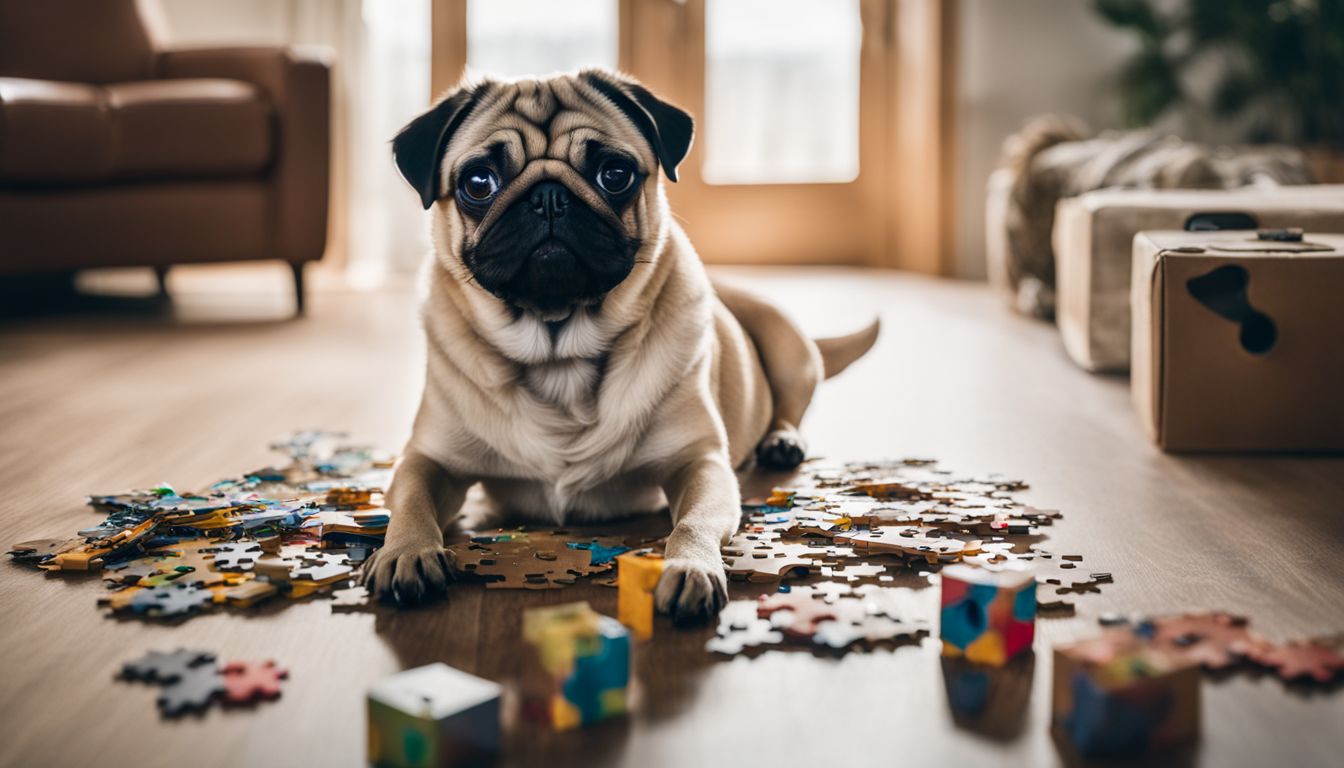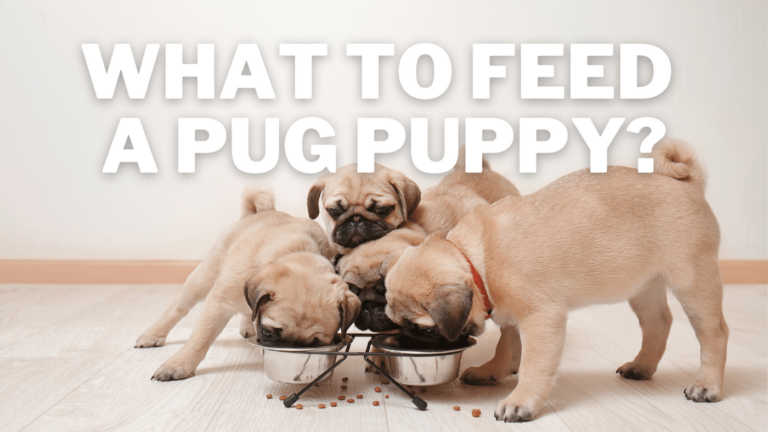Are Pugs Smart? Unveiling Their Intelligence And Problem-Solving Abilities
Are Pugs Smart?
Ever caught yourself gazing into the soulful eyes of your pug, trying to decipher what’s going on in that cute little head? Trust me, you’re in good company; we pug enthusiasts have all spent moments marveling at their charmingly furrowed brows and wondering about the intellect hiding underneath.
Surprisingly, these compact canines boast a brain-to-body size ratio that might just suggest they’re sharper than we give them credit for. So let’s dive into the mental prowess of our snub-nosed friends and explore just how adept they are at picking up tricks and solving puzzles.
Stick around – our pint-sized buddies could teach us a thing or two!
Key Takeaways
- Pugs may not rank as high as Border Collies or Poodles in traditional intelligence tests, but they possess a notable form of adaptive and companionship intelligence. They’re great at sensing human emotions and forming strong bonds with their owners.
- Positive reinforcement is the most effective training method for pugs. Using treats and praise helps them learn quickly and eagerly, reinforcing good behavior while strengthening the owner-pet relationship.
- Despite their middle-of-the-pack ranking in obedience-based intelligence criteria, pugs demonstrate considerable problem-solving abilities. Their large brain-to-body size ratio hints at an innate capacity for cleverness that’s evident in daily interactions.
- Stanley Coren’s Dog Intelligence Criteria suggests that instinctive, adaptive, and working/obedience intelligences are key areas to consider when evaluating dog breeds. While pugs weren’t bred for tasks requiring high obedience or work ethic, they excel at independent problem-solving and adaptability.
- Owners’ experiences confirm that pugs are smart; they can navigate complex situations and learn commands during training sessions effectively. Also, their expressive faces often communicate needs without words, indicating advanced social awareness skills.
The Intelligence of Pugs: Understanding Their Abilities

Pugs often surprise us with their unique blend of charm and cleverness, revealing an intelligence that may not be immediately apparent. Let’s dive into the intriguing world of Pug smarts to understand how these endearing little dogs navigate mental challenges and daily interactions.
History of Pugs
Pugs have always fascinated us with their expressive faces and stocky build, but their history is just as captivating. These charming little dogs hail from China, where they were treasured by emperors for centuries.
Buddhist monasteries in Tibet also held pugs in high regard, often keeping them as pets. The affectionate nature of these dogs alongside their regal history adds a touch of nobility to our homes today.
They traveled across continents, becoming popular among European aristocracy during the 16th century onward. Dutch traders brought pugs from the East to Europe, where they quickly became favored companions in royal courts including that of Queen Victoria who had a particular fondness for them.
Pug’s distinctive features and even-tempered disposition made them not only fashionable accessories for the elite but cherished family members who’ve stood by our sides through generations.
How We Measure Canine Intelligence
Transitioning from the rich history of Pugs, we now delve into how their intelligence is gauged. Scientists and dog experts use various methods to assess canine smarts, looking closely at different types of intelligence.
Working intelligence, for example, measures how well dogs can follow commands and solve problems given by humans. It’s a way to see how quickly and effectively a dog breed can learn new tasks.
Another key component is adaptive intelligence which looks at an animal’s ability to adjust to new situations or environments on their own without human intervention. It’s all about problem-solving skills and learning from past experiences.
Dogs with high adaptive intelligence are often great at navigating obstacles or figuring out solutions independently. This includes recognizing patterns or remembering where treats are stashed! For our beloved Pugs, this kind of smartness shows when they figure out complex games or learn the rules of the house quickly.
Measuring Pug Intelligence

To truly grasp how Pugs stack up in the canine intelligence world, we must dive into credible methods used for evaluating their smarts. Let’s explore where these charming dogs stand when put to test against scientific criteria for dog intelligence.
Coren’s Dog Intelligence Criteria
We know how curious you are about your pug’s smarts. Let’s explore Coren’s Dog Intelligence Criteria, a system developed by psychologist Stanley Coren. It measures dog breeds against three key aspects: instinctive intelligence, adaptive intelligence, and working and obedience intelligence.
Instinctive intelligence refers to what the breed was originally bred for – like herding or hunting – while adaptive intelligence is all about how well a dog can solve problems on its own.
Coren’s criteria also emphasize training: how quickly a breed can learn new commands and obey them. While pugs weren’t traditionally bred for tasks that require high obedience, such as herding like the Border Collie or tracking like the Bloodhound, they still showcase their unique form of cleverness.
They shine in adaptive intelligence with their remarkable problem-solving abilities and are quick learners when it comes to new tricks and commands. This shows us they have an impressive level of smartness for their compact size.
Keep these measurements in mind as we dive into where pugs stand among their canine peers!
Are Pugs Smart – How Pugs Performed
In tests based on Coren’s criteria, our beloved pugs didn’t land at the top of the intelligence rankings. Despite this, we shouldn’t underestimate them. Their problem-solving abilities are remarkable for their size, and they’ve proven to be quick learners when motivated by treats or praise.
Pugs often surprise us with their cleverness; many pug owners will tell you about times their furry friends have solved puzzles or learned a new trick with impressive speed.
Their performance may not match that of a German Shepherd, but what they lack in obedience and working intelligence, they make up for with charm and adaptability. Now let’s explore how these adorable pups compare to some of the smartest dogs out there.
Pugs vs. The Smartest Dogs
While pugs might not top the charts in traditional intelligence rankings, especially when compared to breeds like border collies or poodles, their unique problem-solving skills and emotional intelligence offer a different perspective on what it means to be a smart dog.
Let’s dive into how these charming canines stand up against the “Einsteins” of the dog world.
Where Pugs Rank
As we explore the intelligence of our beloved pugs, we often wonder where they stand in comparison to other breeds. It’s time to take a closer look at their ranking in terms of smarts. Let’s dive into the data that sheds light on how our pugs measure up:
| Breed | Intelligence Ranking | Notes |
|---|---|---|
| Pugs | Average | Remarkable problem-solving abilities; impressive brain size relative to body size |
| Border Collie | Highest | Known for exceptional intelligence and trainability |
| Poodle | Very High | Quick learners with strong problem-solving skills |
| German Shepherd | High | Excel in obedience and working intelligence |
| Golden Retriever | High | Adaptable and eager to please, making them easy to train |
It’s essential to note that intelligence rankings are not the sole indicator of a dog’s value or their suitability as a pet. Every pug brings a unique charm and wit to their family. Next, we’ll discuss the reasons for their ranking and what makes pugs such endearing companions.
Reasons for Ranking Are Pugs Smart
Pugs often fall in the middle or lower end of dog intelligence rankings, but that doesn’t tell the whole story. Their brain size is quite large relative to their body size, which hints at a solid cognitive foundation for problem-solving.
They may not outpace a Border Collie in obedience trials, but pugs excel in social and companionship intelligence. This means they’re especially good at reading human emotions and interacting with their owners.
Their ranking also reflects how they differ from breeds like Poodles and German Shepherds who are known for their work ethic and quick learning abilities. While pugs learn quickly too, they have a reputation for being stubborn sometimes, which can affect how they perform on standardized intelligence tests.
Yet, we must acknowledge their capacity as quick learners under the right conditions – particularly when positive reinforcement is used effectively during training sessions. Let’s explore why these lovable lapdogs are actually quite clever and how best to train them using techniques that align with their unique style of learning.
Reasons Why Pugs Are Smart
When we think of pugs, their affectionate demeanor often overshadows their intellectual abilities. Yet, these charming canines possess a unique brand of intelligence that encompasses strong social awareness and the ability to adapt effectively to their environment.
Companionship Intelligence
Pugs really shine when it comes to companionship intelligence. They have a knack for sensing our emotions and are always ready to offer comfort or celebrate with us during happy times.
Their problem-solving skills often show up in social situations where they must read the room or adapt to different human interactions. This breed proves that intelligence isn’t just about obedience training or tricks; it’s also about forming deep, intuitive connections with their owners.
We often see this emotional intelligence at play when pugs pick up on subtle cues and respond in ways that seem almost human-like. Whether it’s gently nudging a crying owner or engaging in playful activities to lighten the mood, pugs demonstrate a sophisticated understanding of partnership dynamics.
They recognize the importance of their role as companions and excel at being empathetic household members, proving intelligent dog breeds aren’t only measured by standards set by organizations like the American Kennel Club but also by the bonds they create with us every day.
Adaptive Intelligence
Adaptive intelligence shines through in our pugs’ everyday actions. They navigate new situations with a kind of practical smarts that might surprise you. Consider their keen ability to learn routines; they quickly figure out when it’s time for walks or meals, and they adapt their behavior accordingly.
This aspect of their intelligence makes them fantastic companions in daily life.
In training sessions with these lovable pooches, we leverage their adaptive intelligence by using positive reinforcement techniques. Offering praise and treats not only motivates them but also taps into their natural problem-solving skills, which are quite impressive for their size.
As we move from understanding how smart pugs really are to delving into effective training techniques, keep in mind the power of encouragement and consistency – keys to unlocking your pug’s potential!
Effective Training Techniques for Pugs
To unlock the potential of their unique intelligence, Pugs require specific training methods tailored to their personality and cognitive style. We’ve learned that this breed responds exceptionally well to consistent routines and positive reinforcement—key components in effective pug education that can truly enhance the owner-pet relationship.
Positive Reinforcement
Positive reinforcement works wonders with pugs, tapping into their natural intelligence and eagerness to please. As we train our furry friends, using treats and praise not only makes the process enjoyable but also helps them learn quicker.
Each time they follow a command or show signs of understanding, a reward reinforces their good behavior. This method builds confidence in our companions, encouraging them to repeat actions that earn positive outcomes.
Keep your training sessions short, fun, and full of encouragement when working with these smart pups. Pugs thrive on affectionate interaction and the mental stimulation that comes from learning new tricks or commands.
With consistency and patience, you’ll find your pug mastering tasks faster than expected – all thanks to the power of positive reinforcement that aligns perfectly with their problem-solving prowess.
Negative Reinforcement
In training our pugs, we sometimes turn to negative reinforcement. This involves taking away something the dog doesn’t like when they follow our command. For example, we might stop a loud noise as soon as our pug sits down if it’s trying to avoid the sound.
It’s not about punishment; instead, it helps them learn that good behavior can make uncomfortable things go away.
It’s crucial to use this technique carefully and sparingly with pugs since their smart nature responds well to positive methods like treats and praise too. While negative reinforcement can be effective in certain situations, always prioritizing their health and emotional well-being is important for us as responsible pet owners.
We aim for a balanced approach that respects both the intelligence of dogs and nurtures a happy relationship with our furry friends.
How Pug Intelligence Impacts Their Owners
The cleverness of pugs extends far beyond their charming expressions; it significantly influences how we interact with and integrate them into our lives. Discovering the nuances of a pug’s intelligence can transform the way owners approach training, companionship, and daily activities with their furry friends.
Choosing Pugs as a Companion
Pugs often rise to the top of the list for those looking into companion dogs. Their intelligence shines through in their adaptability and eagerness to be part of family activities.
We understand that a smart dog is more than just one who can follow commands; it’s one that connects with you on an emotional level as well. Pugs excel at this, bringing joy and laughter with their expressive faces and lovable antics.
Embracing a pug means acknowledging their impressive problem-solving abilities and willingness to learn, making them delightful companions for various households. Many of us value these small dogs not only because they’re quick learners but also due to their sizeable brain-to-body ratio which equips them for both tricks and deeper bonds with owners.
As we go about our daily routines, pugs prove themselves as adaptable pets ready to engage in life alongside us, whether it’s learning new games or simply cuddling on the couch after a long day.
Training and Bonding Opportunities
Training your pug provides an amazing chance to strengthen the bond between you and your furry friend. Using positive reinforcement, such as offering treats and praise, taps into their remarkable intelligence and quick learning abilities.
Keep sessions short, fun, and consistent; this not only helps your pug pick up commands but also turns training into a game they’ll always be excited to play with you.
These clever little dogs thrive on attention and interaction, making each successful training session a step forward in forging a deep connection that goes beyond basic obedience. As we move on from how intelligent our beloved pugs are to analyzing real-life experiences from owners, it’s clear that these problem-solving companions are more than just pets—they’re part of the family.
Real Owner Answers: Are Pugs Smart?
In our quest to understand pug intelligence, we’ve turned to the experts—pug owners themselves. Their firsthand experiences provide authentic insights into whether these charismatic canines are as smart as they are charming.
Personal Experiences with Pugs
As pug lovers, we relish every moment spent with our endearing pets. Their intelligence and problem-solving abilities make each day interesting and rewarding.
- Many of us have witnessed a pug’s remarkable ability to navigate out of a complicated situation. For example, they can often extricate themselves from underneath bed covers or find their way around furniture barriers that block their path to a beloved toy.
- Pugs show us time and again how quickly they learn commands during puppy training sessions. With consistency, patience, and the use of positive reinforcement like treats, they can master basic commands like “sit” and “stay” faster than we expect.
- The expressions on our pugs’ faces are not just adorable; they communicate needs effectively. They tilt their heads when curious or puzzled and make it evident when they’re craving companionship or playtime.
- Our community shares stories of pugs demonstrating adaptive intelligence by adjusting behaviors according to the mood of their human family members – a trait that makes them such cherished companions.
- Pugs thrive with social interactions within human families but also perform well in crate training for alone times. This adaptability showcases their understanding of routine and security.
- We’ve noticed that despite not being cattle dogs bred for high – level tasks, our pugs still engage with challenges involving food puzzles or interactive games which stimulate their minds.
- Some owners have even trained their pugs to recognize words related to specific toys or activities, proving that language isn’t an obstacle for these alert animals.
- Anyone who has lived with a pug knows they have unique ways of solving problems; if reaching a favorite spot on the couch seems tough, don’t be surprised to see your pug build an improvised ramp using cushions.
Are Pugs Smart Conclusion
In closing, pugs showcase a delightful blend of intelligence and charm. Their problem-solving skills shine when given engaging tasks or during training sessions. If you’re seeking a smart companion with a playful spirit, pugs might just steal your heart.
They adapt well to positive reinforcement and can impress owners with their quick learning abilities. Remember, the connection you build while teaching your pug will often reflect their willingness to learn and succeed.
Are Pugs Smart FAQs
1. Are pugs smart compared to other popular dogs?
Pugs might not be as well-known for their intelligence like Dobermans or Beagles, but they show smarts in their own unique ways, often surprising owners with their problem-solving abilities.
2. What kind of intelligence do pugs have?
While they may not match the human intelligence measures from the American Psychological Association, pugs display a type of animal intelligence that shines in social situations and bonding with families.
3. Can pugs learn tricks and commands like French Bulldogs or Maltese?
Yes, pugs can learn various tricks and obey commands just like French Bulldogs and Maltese when trained consistently; patience from the owner is key!
4. What do veterinarians say about a pug’s intelligence?
Veterinarians acknowledge that while Pugs may require more time to learn than some breeds, consistent positive reinforcement techniques recommended by Petplan can help unlock their potential for learning effectively.







